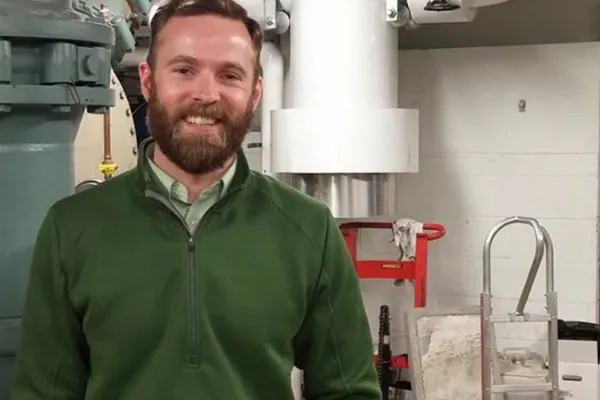Prospects for a Greener Smith: An Interview with Smith's New Campus Energy Manager
Sustainability

Published April 8, 2016
Matthew Pfannenstiel, Smith’s new campus energy manager, has been interested since his teens in how buildings are designed and used.
The recipient of a bachelor’s degree in science and engineering and a master’s in architectural engineering from the University of Nebraska, Pfannenstiel has worked on engineering design projects for the University of California Berkeley, MassMutual, Apple and Marriot—among others.
He also managed a project designing and constructing a prototype classroom for a long-term renovation of the American School of Kinshasa in the Democratic Republic of Congo—an experience that involved working closely with students, teachers and administrators.
At Smith, where he began work earlier this semester, Pfannenstiel is responsible for developing a comprehensive approach to reducing campus energy use and greenhouse gas emissions. To meet that challenge, Pfannenstiel works with students, faculty and staff, as well as representatives of local utilities and government agencies.
An avid hiker and outdoor recreation enthusiast, Pfannenstiel says his interest in sustainable energy is tied to his love for undeveloped spaces.
“Energy conservation helps us preserve those undisturbed places,” he says. “I want to help keep them around for as long as possible.”
Here’s what Pfannenstiel had to say about his work at the college:
What drew you to the position at Smith?
“When my wife and I first moved to Northampton in 2012, we would often walk our dog near the campus. You could see that it was a place with a lot of history, and buildings with mechanical systems from different eras. I always thought it would be fun to be on a campus with that kind of history—a place where I could apply my background in engineering.”
What opportunities do you see for the college to save energy?
“The campus is well run. The power plant, with its co-generation system, is a great use of technology. Still, there are opportunities to get that power plant to sync better with other energy systems on campus. Some buildings will have more energy-saving prospects than others. We know labs will be big consumers of energy because of the additional heating and cooling required. So we’re taking a look at the amount of exhaust coming out of our labs and what opportunities there might be for harnessing and reducing that exhaust. We’ve also begun a metering program so we can really see how our buildings compare with each other—and with other campuses—as far as energy use.”
How will your work help further Smith’s commitment to becoming carbon neutral by 2030?
“That’s a big, ambitious goal—the kind I like to see. Getting down to being carbon neutral is not going to be about one single project. It’s going to be the sum of a lot of smaller projects—along with some big ones. As we move toward that goal, my approach is to make the campus more efficient without negatively impacting our comfort level with how we use our buildings. I’m not here to turn everyone’s lights off or have buildings be 80 degrees in summer. I want to learn about how we use our buildings so we can make a positive impact on our energy consumption.”
Are you working with students on energy management?
“Yes. I recently attended Professor Denise McKahn’s thermodynamics class, where students are working on different types of projects related to heating and cooling systems. That kind of involvement of students in campus energy use is great! It extends my eyes and ears and helps identify new areas and ideas for improvements.”
What’s the most memorable campus building you’ve toured so far?
“The basement of Sabin-Reed was an eye opener. Construction of that space dates to the 1970s, and it’s a bit of an industrial labyrinth. I was also on top of Neilson Library when it was about 10 degrees outside, which gave me a brief—but nice—view of the campus.”
What’s most important for campus community members to know about your role as energy manager?
“When I worked as a design engineer, there were lots of different projects running at the same time. Here, I am still involved in lots of projects, but I get to be more involved in project development, and will be able to stay with projects and see them through. Significantly reducing our energy use at Smith is going to take some rethinking about the way we are powering, heating, cooling and using our buildings. We also have to find exciting ways to communicate with the campus as a whole and get people motivated to make changes.”